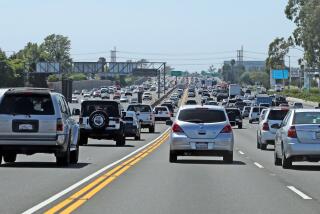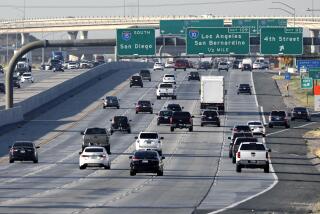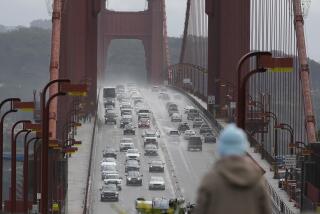Tough Traffic--and the Laws to Match
California’s streets and highways may be clogged with traffic, but drivers can rest assured those roads are covered by the best traffic safety laws in the nation, a new study says.
Unlike the wide-open state of Montana, for example, California has red-light cameras, motorcycle helmet laws and procedures for immediate suspension of suspected drunk drivers’ licenses, the Insurance Institute for Highway Safety study pointed out.
More important, the Golden State is fairly vigorous in enforcing its laws, the Virginia-based insurance industry research group said in its inaugural review of state traffic safety laws. The report was released Wednesday.
As the only state to receive top scores in all five categories studied by the insurance institute, California is ranked No. 1 overall, followed by the District of Columbia and Maryland. South Carolina, South Dakota and Montana have the weakest traffic safety laws, the institute concluded.
The study looked for the presence and application of laws concerning alcohol- and substance-impaired driving; young-driver licensing and vehicle-use restrictions; use of child safety restraint systems; motorcycle helmet use; and camera enforcement of red-light violations. Complete results are available on the institute’s Web site at https://www.highwaysafety.org.
“We know, based on accident and safety research, that these laws work, so we looked to see who’s got them and who doesn’t, and where they were strong and where they were weak,” said Allan Williams, the institute’s senior vice president.
The study’s findings “show that states without these laws, or with weak application of them, need to do more. That California has strong application of laws in all five categories shows that it can be done.”
But even California doesn’t do everything right, Williams said. Unlike some other states, for example, it doesn’t impose restrictions on late-night driving for teenagers until midnight.
“A lot of other states start restrictions at 9 p.m. for the youngest drivers,” Williams said, “because studies show that most nighttime crashes involving 16- to 18-year-old drivers take place before midnight.”
The recent development of traffic cameras that can photograph license plates of vehicles that run red lights has slashed such violations by 40% in places, such as Oxnard, that use them. But only six states, including California, have laws permitting statewide use of the cameras, the study found.
“Red-light-running kills hundreds of people every year,” Williams said. “To make a dent in this toll, we’ve got to encourage the use of the camera technology.”
In the critical arena of driving while alcohol-impaired, laws permitting administrative license revocation immediately after an arrest are “the cornerstone of an effective DUI or DWI program,” Williams said.
New Hampshire is dinged as the only state without a mandatory seat-belt law, but the study also shows that only 17 states--California included--allow police to stop drivers solely for seat-belt violations.
The study was especially critical of weak laws governing use of child safety restraints, noting that 14 states don’t require children who are too old for child safety seats to wear seat belts in the back seats.
“This makes no sense,” Williams said. “The back seat is where we tell parents it’s safest for their children to ride, so laws should cover the kids who sit there.”
A representative of a Southern California traffic safety group applauded the study as a valuable guide for families planning trips.
“You can find out which states have laws in place to help protect you,” said Reidel Post, executive director of Mothers Against Drunk Driving/Orange County. “And it is great that California’s efforts are recognized, but there’s always room for more improvement.
“Traffic collisions are a great cause of death in our society, so we always need to be looking for more mechanisms to help ensure our safety.”
More to Read
Sign up for Essential California
The most important California stories and recommendations in your inbox every morning.
You may occasionally receive promotional content from the Los Angeles Times.










